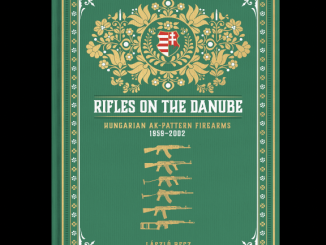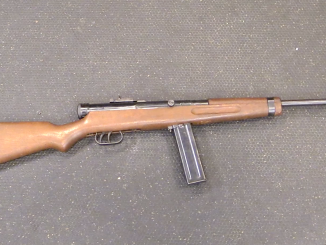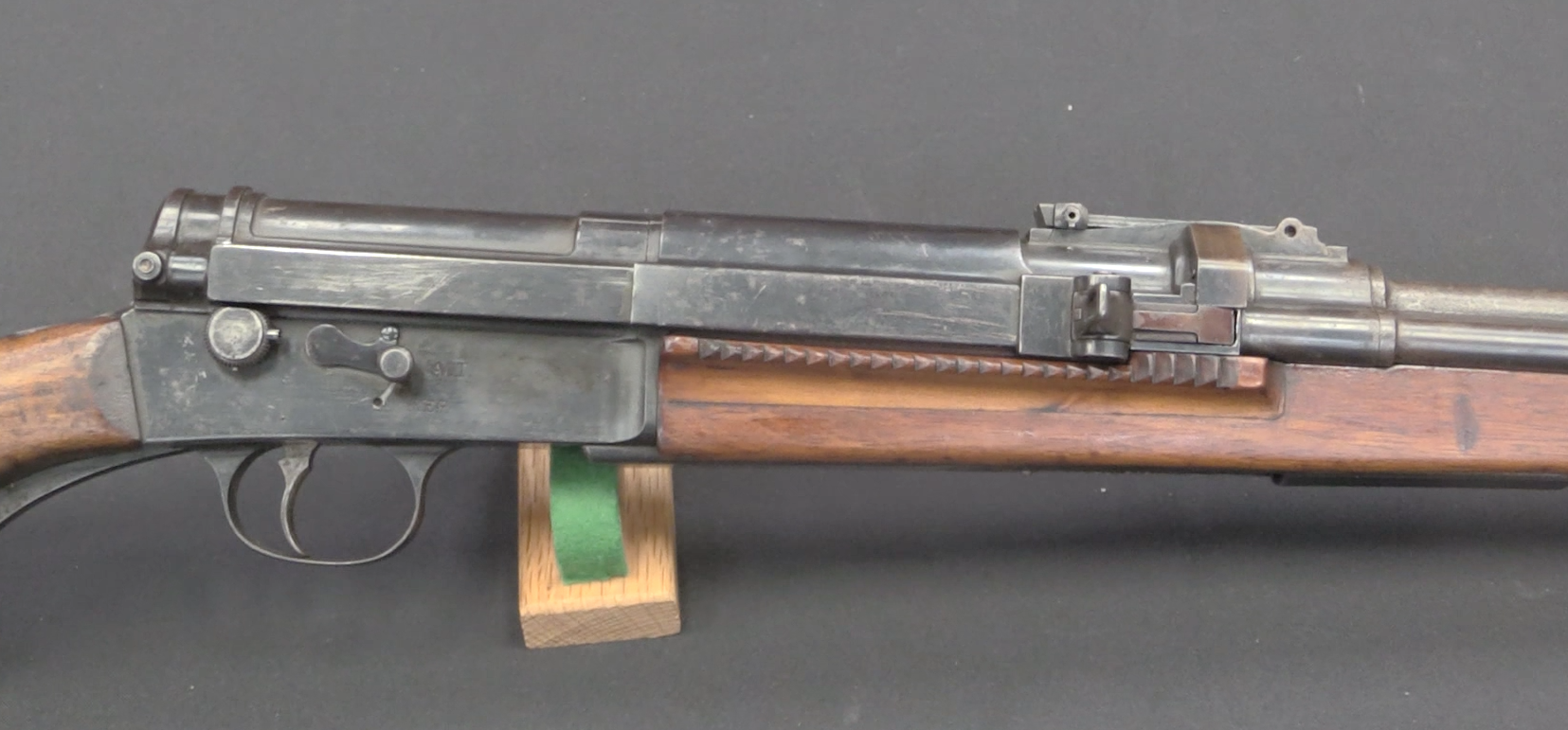The Hungarian AMP-69 is, I think, the undisputed ugliest military AK variant ever fielded. It is truly an example of function over form, designed specifically for the role of dedicated rifle grenade launcher. To this end, the muzzle is fitted with a grenade spigot, a side rail mounts a high-angle optical sight, both the hand guard and buttstock are fitted with recoil-absorbing springs, and the pistol grip is made of a pliable rubber. The standard magazine was a 10-round one with a block in the front to prevent regular ammunition from being loaded. Hungarian rifle grenades used with the AMP-69 were launched with blank cartridges, and were not pass-through or bullet-trap designs.
Related Articles

Video
Rifles on the Danube: Hungarian AK-Pattern Firearms – NOW SHIPPING
Now Shipping! Order your copy here: https://www.headstamppublishing.com/danube-book At the end of the Second World War, Hungary was occupied by Soviet troops and soon fell into the Soviet sphere of influence, joining the Warsaw Pact in […]

Uncategorized
San Cristobal Model 2: A Lever-Delayed .30 Carbine
The San Cristobal armory was a surprisingly large-scale arms manufacturer set up in the Dominican Republic in the late 40s. They produced several different weapons, but the most common was the Model 2 Cristobal carbine. […]

Prototype
Frommer Prototype Semiauto Rifle (Video)
Rudolf Frommer was a self-taught engineer and firearms designer who worked his way up through the FEG concern in Budapest to eventually hold the position of CEO. During this time he developed a series of […]

I know blanks are still nasty to anyone stupid enough to put his head near the muzzle of this grenade launcher. The gas pressure alone would blow your brains out!
“Hungarian rifle grenades used with the AMP-69 were launched with blank cartridges, and were not pass-through or bullet-trap designs.”
AMP-69 is very similar to Karabinek-granatnik wzór 1960 adopted few year earlier in Poland: https://en.wikipedia.org/wiki/Kbkg_wz._1960
I am wondering if grenades launcher were interchangeable? I.e. if it was possible to fire Polish grenade from Hungarian weapon or Hungarian grenade from Polish weapon?
Anyway it looks that WarPact members have relative discretion in introducing own grenade launcher and its ammunition, take for example later PALLAD:
https://modernfirearms.net/en/grenade-launchers/poland-grenade-launchers/pallad-eng/
so far I know its ammunition was unique and not used in any other weapon of another WarPact member.
For adding variety, I might add Soviet Union produced VG-45 for SKS and VG-44 for Mosin carbine:
https://sovietarmorer.wordpress.com/2015/08/11/rifle-grenade-launchers-vg-44-and-vg-45/
although it is earlier development than Hungarian weapon, with production no later than 1951. Information about actual usage, even in Russian language, are very humble if not non-existent, here: https://forum.guns.ru/forummessage/36/2132287.html information about quantity of examples are given, full production of ONE plant was overall (both variants) under 70 000 examples, with first batch made in February 1951 and last in June 1953, there is note production was transfer to another plant without any further explanation.
is: “(…)grenades launcher(…)”
should be: “(…)grenades for these launchers(…)”
“I am wondering if grenades launcher were interchangeable? I.e. if it was possible to fire Polish grenade from Hungarian weapon or Hungarian grenade from Polish weapon?”
I do not know, but I bet it is a strong “no”. As far as I know, there was never any cooperation between Hungary and another Warsaw Pact country, except lincencing designs from Soviet Union.
I can only support this notion. During my service in CSLA there were not grenades fired off rifles at all. This leads me to think that rifle grenades use was responsibility of individual WP member armies.
“During my service in CSLA there were not grenades fired off rifles at all.”
Although, at some, apparently grenade launching-capable derivative of vz. 58 was crafted under code-name VG-70 or grenade thrower, see photos and info:
http://www.militaria.wz.cz/cs/sa-58/vg70.htm
I do not understand enough to say when (which year) it was developed, but apparently it never advanced past prototype stage.
For reasons unclear for me they decided caliber to be 26,5 mm i.e. same as their default flare gun. That allowed to fire ammunition for flare gun using this one, but I wouldn’t want situation when someone pack ammunition for this into flare gun (unless this one produce less pressure than flare gun can withstand, which I found unlikely).
Only ammunition which I was able to detect, made specifically for this, was HEAT. It could penetrate 70 mm if impact at right angle. Which is rather low, even by early Cold War-era standards, but not surprising considering small caliber*.
*or strictly speaking warhead diameter, which not necessary match caliber of weapon, as it is possible to combine cup-type grenade launcher with over-caliber see GewehrPanzergranate 61 http://www.lexpev.nl/grenades/europe/germany/gewehrpanzergranate61.html
Very good find, Daweo. Thank you.
When I look at parameters of proposed grenade it is very close to that of 40x46mm LV. With that miniature 26.5mm caliber it should fly with lesser effort. Also, it is of interest that launcher’s breech opens sideways, much like similar weapon by HK.
One note on side. It is remarkable that lots of new activity in terms of product development occurred (became visible) in late 60s. I am quite sure it had to do with reformist spirit of the time. There was lots of hope then, followed by depression as consequence of coup conducted by ‘old guard’.
Regarding cooperation or equipment sharing, yes the was some among individual member states. For instance, our armed forces implemented light reconnaissance amphibious vehicle originated in Hungary.
Rifle grenades are not painful to shoot. This is a myth. I have fired inert grenades with the correct launching “blank” and it is quite mild.
Actually, this depends on design and proper technique. If you try to fire a grenade with the rifle butt at your shoulder, you may inflict pain upon yourself. I wonder if anyone skipped training and found out the hard way…
U.S. training always has the butt firmly planted on the ground. In fact, the clinometer sight on the old M1 Garand can only be used correctly if the rifle butt is grounded.
The M-16/M-203 combination is normally fired with the butt clamped under the elbow, again the clinometer can really only be used properly in this way. Only the M-79 was designed to be fired from the shoulder in the “usual way”.
The Super Energa rocket-boosted AT rifle grenade;
https://en.wikipedia.org/wiki/ENERGA_anti-tank_rifle_grenade
Could be fired off the FAL from the “couched” position, relying on the rocket booster to do most of the work, but most soldiers afflicted with the beast quickly learned that turning their faces away from the rocket, which fired instantly on launch, was highly recommended from a safety standpoint. Unfortunately, this did nothing to improve the accuracy.
There’s a reason most armies today use dedicated rocket launchers or etc. broadly based on the American “Bazooka” of WW2, the German Panzerfaust recoilless gun, or a hybrid of both like the Russian RPG-2 through -7 series.
cheers
eon
“Energa”
Excerpt from
Infantry Training
Volume 1
INFANTRY PLATOON WEAPONS
PAMPHLET No. 9, PART 1
THE ANTI-TANK GRENADE, No.94
(ENERGA)
could be seen here:
http://www.bocn.co.uk/vbforum/threads/23746-Energa-AT-rifle-granade
it shows firing should be done with butt against elbow
“There’s a reason most armies today use dedicated rocket launchers or etc. broadly based on the American “Bazooka” of WW2, the German Panzerfaust recoilless gun, or a hybrid of both like the Russian RPG-2 through -7 series.”
From major powers, France seem to have retain anti-tank rifle grenades in their inventory: https://en.wikipedia.org/wiki/APAV40 but I do not know if it could be launched from HK416? Or is it (APAV40) still in production?
Then why is there a peep sight on the grenade launching sight? The literature with the sight illustrates both shoulder fired (direct fire) and the butt planted on the ground using the clinometer (indirect fire). There is plenty of actual footage from WWII showing grenades being launched with the rifle shouldered. As I said, I’ve done this myself several times and the recoil is no biggie. I have the correct launching blanks and two types of inert projectiles that are the same weight as the real thing.
There is a reason why M16A2 muzzle compensator has diameter 22mm (0.87in). It was intended to match muzzle grenades made by Mecar and other companies derived from Energa.
Real blast is when you try to, in the heat of the battle, fire it with live round (out of yugo m70).
It happened to one guy, today lower level politician, lost only few of the fingers (if its true he lost it in that way exactly, it was/is not uncommon to fabricate many things and stories).
In the hands of poorly trained, some firearms can be extremely dangerous to them and surrounding people.
Ian, the sight appears to work on the same principle as the modern “See all sight”. Half of the optics is occupied with a lens that magnifies a reticle and makes it appear in a distance. The other half allows you to view the target. The result is somewhat similar to a red dot sight, but you only can see the reticle in the lower half of the sight, and the target in the upper half. On the plus side, it is very rugged and does not need a battery / electronics.
Bump fire handguard anyone? Lool
The bump fire stocks are already banned so handguards may be next.